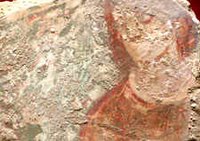Painted Bas-Reliefs of Sasanid Imperial Family Unearthed in Gur

LONDON, 18 February 2006 (CAIS) -- The team of archaeologists working at the Sasanid city of Gur has completely unearthed the bas-reliefs of four members of the Sasanid imperial family which they had discovered in the Menarshahr region of the ancient site in early January, the Persian service of CHN reported on Saturday.
Carved on one of the walls of a newly discovered palace at the site, these colorful unique bas-reliefs depict two princesses along with a prince and child with a calf. The team had previously unearthed only the heads of the bas-reliefs and knew nothing about their clothing or other accessories.
“The imperial family members are all young, and this is the first time such bas-reliefs have been discovered from the era when King of Kings Ardashir I (224-241 CE) reigned,” the head of the archaeological team, Leili Niakan, said.
"All of the bas-reliefs are intact except one of the princesses, whose head has been destroyed by the ravages of time", she added.
“These bas-reliefs show the continuity and survival of Parthians art during the Sasanid dynastic era in its early stages. The colors have skillfully been used as the bas-reliefs seem alive on the walls. They have used green and crimson to paint the shapes,” Niakan explained.
“The child seems to be the son of the princess standing beside him. The prince stands beside the other princess with a certain dignity. The clothing of the princess indicates that she also is young and may be the wife of the prince,” she added.
Located 10 kilometers from Firuzabad in Fars Province, the circle-shaped city of Gur was the first capital of the forth Iranian dynasty, the Sasanids, which was established during the reign of the founder of the dynasty, king of kings Ardashir I. Very few studies have been carried out on the city, which is one of the five most important Sasanid cities. It covers an area of 300 hectares.
The excavations are being carried out in order to save the site, which is threatened by farmers who are cultivating the lands beneath which most of the ancient city lies buried.
Over 30 percent of the upper level of the city has been flattened and its walls have been seriously damaged by farmers’ activities over the centuries.

0 Comments:
Post a Comment
<< Home